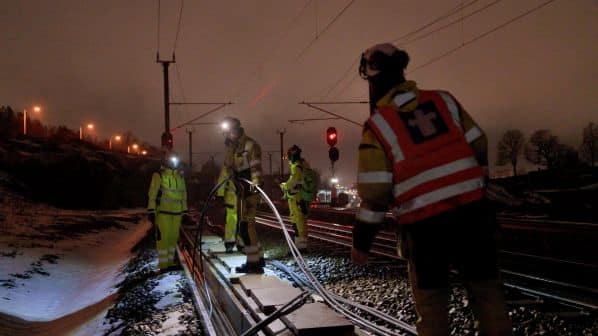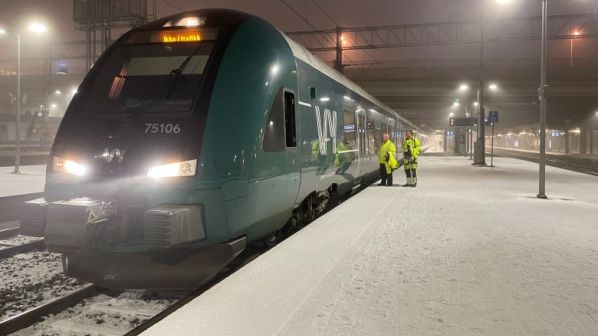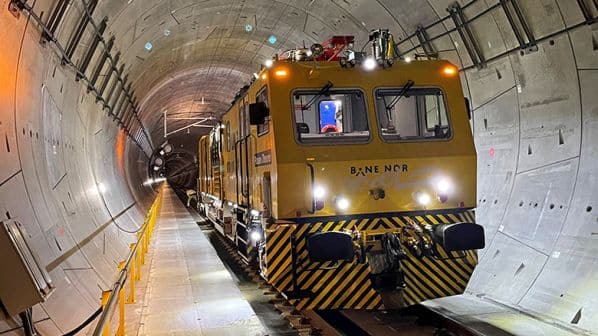NORWEGIAN infrastructure manager Bane Nor is continuing to conduct testing on the Follo Line, the 22km railway between Oslo and Ski, which closed in December weeks after its official opening due to repeated problems.
King Harald of Norway officially opened the new railway, which runs through the Nordic countries’ longest tunnel, on December 12. The line is supposed to cut journey times on the Oslo - Ski route by 50% to 11 minutes.
However, the line was closed temporarily on December 19 after smoke and heat were detected within the tunnels and in a technical building in Ski. These issues happened again on December 23, and the line was closed to allow further testing to take place. Passenger trains were diverted to the existing Østfold Line. Another overheating incident occurred during testing on January 11.

The board of Bane Nor has appointed PwC to evaluate the project, and determine the sequence of events that led to the closure. The study is due to begin in mid-March and be completed in mid-June 2023.
Bane Nor says it has been carrying out various tests since mid-January, including inspecting nearly 100 electrical connections. It also repaired the joints and end terminals of the electrification subsystem.
Work began on the Blix Tunnel in September 2016 and tunnelling was completed on February 26 2019. Although the tunnel length is around 20km, the choice of separate bores for each track raised the total length of bored tunnel to 36km. Tunnel construction was carried out by a joint venture led by Acciona and Gheller (AGJV) under a contract awarded by Bane Nor.
Bane Nor published an initial report into the causes of the closure on February 13, which is available in Norwegian here.
It found that:
- the installed cable for return current has been vulnerable to overheating. Factors which played a role probably included incorrect installation of joints and end terminations, in combination with the design in which the cable shield was earthed at both ends.
- water made alkaline by the cement in the tunnel sealant and concrete has dripped onto an insulator in the tunnel roof. This has led to several temporary short circuits of the traction current.
- in these cases, the short-circuit protection had a delayed disconnection of the current, which could have increased the short-circuit load on the system. Interconnections made in conjunction with troubleshooting when the incidents occurred may have caused additional stress.
- the combination of the above issues could have led to damage to the cables and thereby a permanent short circuit of the plant.
The line uses an electrification system with separate cabling for return current, which is different to that used elsewhere in Norway. The locomotive draws power from the overhead catenary to power the traction system, and the current is returned to the supply station by cable. This is unlike a traditional solution, where the high-voltage cables are earthed at one end.
The system was selected by AGJV.

“The contractor is free to choose technical solutions as long as they are within the criteria, including Bane Nor’s Technical Regulations, as well as all Norwegian laws and regulations for such facilities,” Bane Nor says. “It is AGJV that has designed this facility with the help of its subcontractors.”
An independent assessment from Norconsult was commissioned to ensure that the system would work before it was put into operation. The report largely focused on how the return current system would affect the signalling system at Oslo main station. The Norconsult report is available here.
The report found that the solution was in accordance with the technical regulations, and that with the appropriate design it was considered unlikely that earthing at both ends would pose a problem.
Reopening
The line was initially due to reopen on February 1 but this was delayed to February 12, with Bane Nor then announcing on January 19 that the reopening had been postponed indefinitely. In an update published on February 22, Bane Nor said it would meet with national operator Vy on February 24 to decide whether the line is ready to reopen on March 5.
A temporary timetable was introduced on the Østfold Line on January 9. However, Vy was unable to revert back to the timetable used before the opening of the Follo Line, due to changes to several other rail services and bus networks across Oslo at the December timetable change.
A comprehensive quality programme was carried out during the planning, construction and testing of systems on the line, and more than 200 test trains were run through the tunnel ahead of the line opening. However, Bane Nor says this was evidently not enough to detect the issues.
For detailed data on rail projects around the world, subscribe to IRJ Pro.

